HR Marketing and Business: London Ambulance Service Challenge Analysis
VerifiedAdded on 2023/01/07
|8
|2535
|41
Report
AI Summary
This report analyzes the challenges faced by the London Ambulance Service (LAS), focusing on the critical issue of meeting and controlling demand. The analysis employs the PEST model to identify external factors such as political instability due to Brexit, economic constraints from reduced NHS funding, social factors including the desirability of paramedic jobs, and technological advancements requiring a skilled workforce. The report proposes solutions centered on boosting the workforce through recruitment strategies targeting BAME Londoners and the implementation of the SAFe model to improve team collaboration and efficiency. It also suggests online HR training programs to upskill staff and address workforce shortages. The report concludes by proposing a SMART-based online training program for 50 apprentices, aiming to improve human resource management, increase the talent pool, and address challenges related to workforce availability and demand.

HR Marketing and
Business
Business
Paraphrase This Document
Need a fresh take? Get an instant paraphrase of this document with our AI Paraphraser
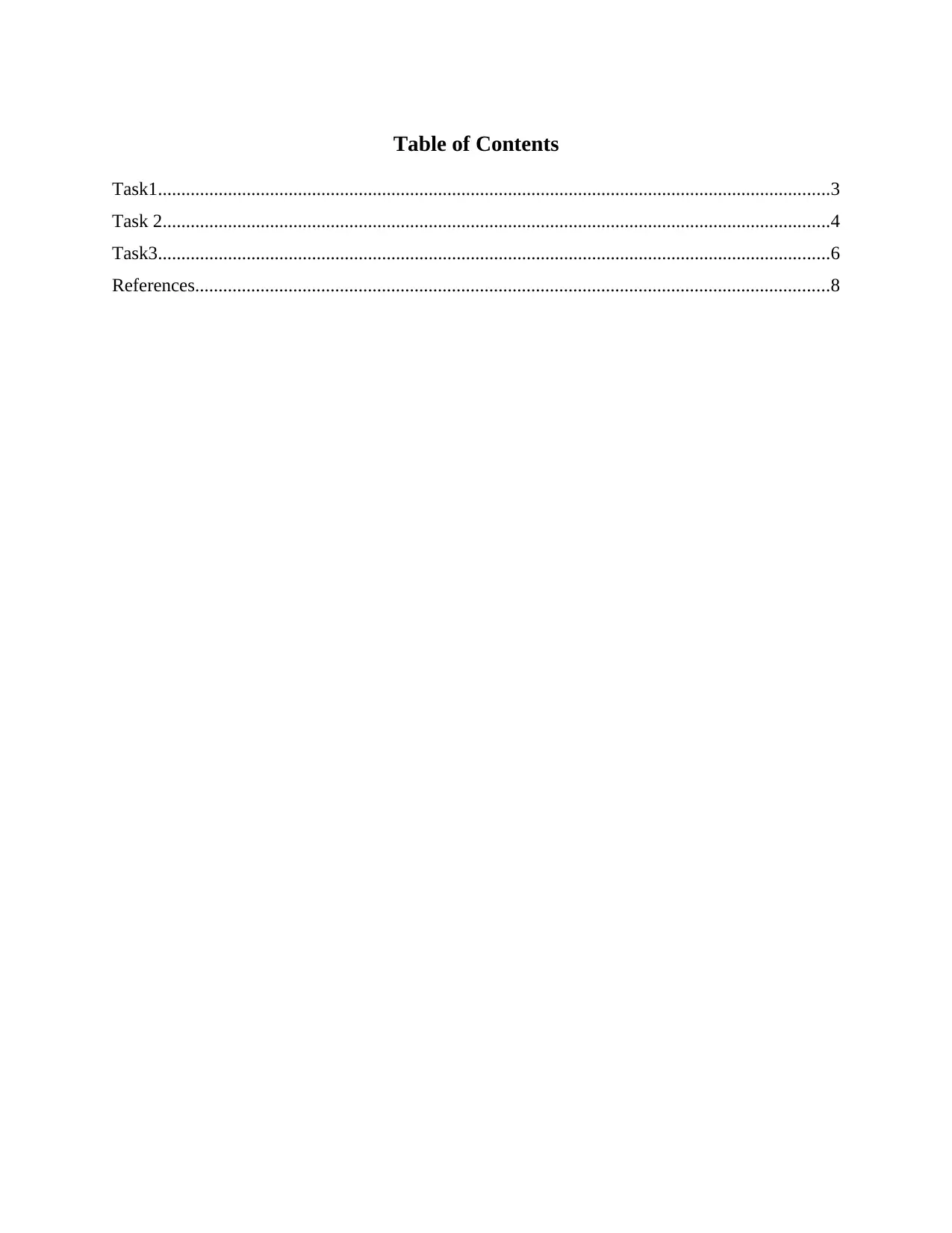
Table of Contents
Task1................................................................................................................................................3
Task 2...............................................................................................................................................4
Task3................................................................................................................................................6
References........................................................................................................................................8
Task1................................................................................................................................................3
Task 2...............................................................................................................................................4
Task3................................................................................................................................................6
References........................................................................................................................................8
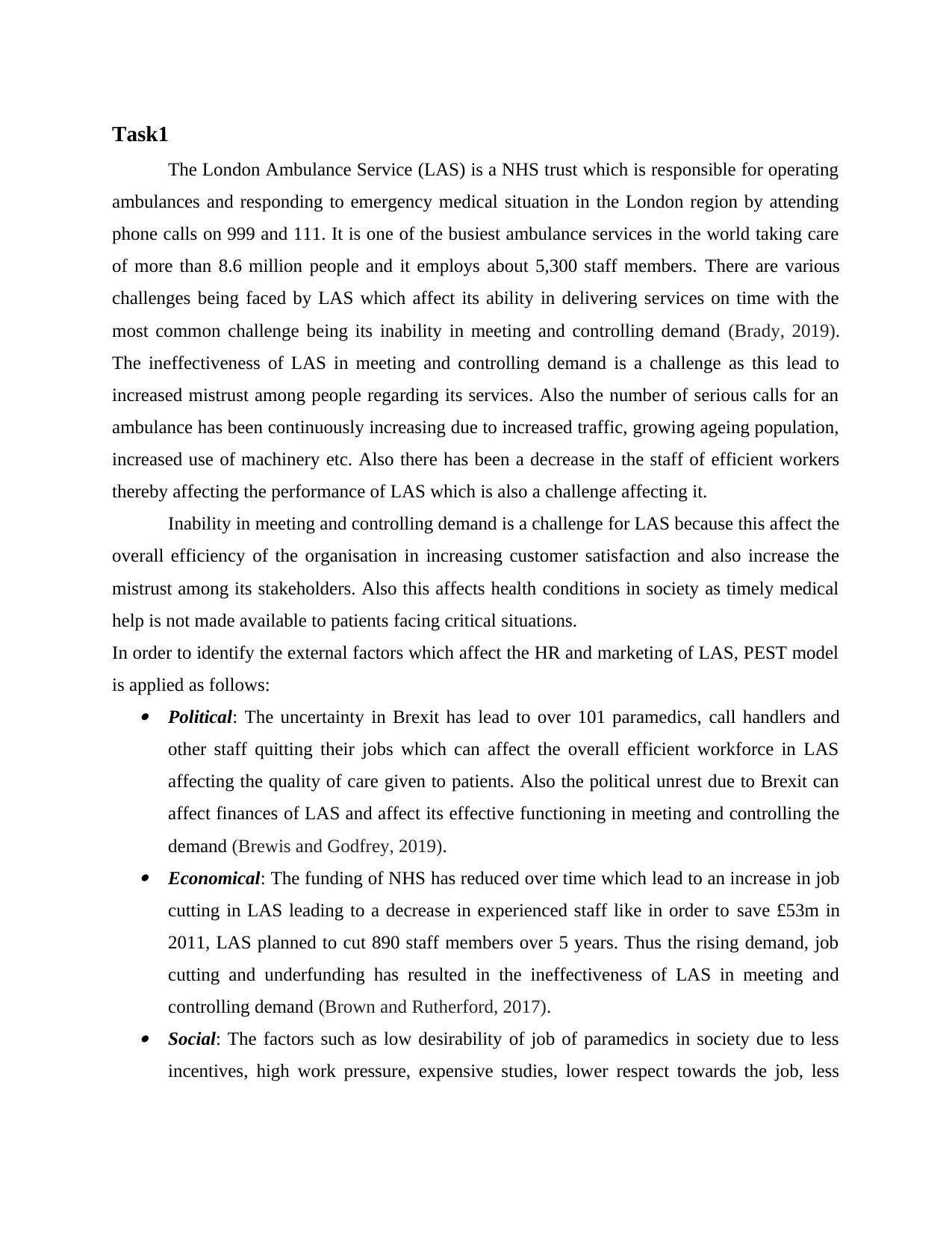
Task1
The London Ambulance Service (LAS) is a NHS trust which is responsible for operating
ambulances and responding to emergency medical situation in the London region by attending
phone calls on 999 and 111. It is one of the busiest ambulance services in the world taking care
of more than 8.6 million people and it employs about 5,300 staff members. There are various
challenges being faced by LAS which affect its ability in delivering services on time with the
most common challenge being its inability in meeting and controlling demand (Brady, 2019).
The ineffectiveness of LAS in meeting and controlling demand is a challenge as this lead to
increased mistrust among people regarding its services. Also the number of serious calls for an
ambulance has been continuously increasing due to increased traffic, growing ageing population,
increased use of machinery etc. Also there has been a decrease in the staff of efficient workers
thereby affecting the performance of LAS which is also a challenge affecting it.
Inability in meeting and controlling demand is a challenge for LAS because this affect the
overall efficiency of the organisation in increasing customer satisfaction and also increase the
mistrust among its stakeholders. Also this affects health conditions in society as timely medical
help is not made available to patients facing critical situations.
In order to identify the external factors which affect the HR and marketing of LAS, PEST model
is applied as follows: Political: The uncertainty in Brexit has lead to over 101 paramedics, call handlers and
other staff quitting their jobs which can affect the overall efficient workforce in LAS
affecting the quality of care given to patients. Also the political unrest due to Brexit can
affect finances of LAS and affect its effective functioning in meeting and controlling the
demand (Brewis and Godfrey, 2019). Economical: The funding of NHS has reduced over time which lead to an increase in job
cutting in LAS leading to a decrease in experienced staff like in order to save £53m in
2011, LAS planned to cut 890 staff members over 5 years. Thus the rising demand, job
cutting and underfunding has resulted in the ineffectiveness of LAS in meeting and
controlling demand (Brown and Rutherford, 2017). Social: The factors such as low desirability of job of paramedics in society due to less
incentives, high work pressure, expensive studies, lower respect towards the job, less
The London Ambulance Service (LAS) is a NHS trust which is responsible for operating
ambulances and responding to emergency medical situation in the London region by attending
phone calls on 999 and 111. It is one of the busiest ambulance services in the world taking care
of more than 8.6 million people and it employs about 5,300 staff members. There are various
challenges being faced by LAS which affect its ability in delivering services on time with the
most common challenge being its inability in meeting and controlling demand (Brady, 2019).
The ineffectiveness of LAS in meeting and controlling demand is a challenge as this lead to
increased mistrust among people regarding its services. Also the number of serious calls for an
ambulance has been continuously increasing due to increased traffic, growing ageing population,
increased use of machinery etc. Also there has been a decrease in the staff of efficient workers
thereby affecting the performance of LAS which is also a challenge affecting it.
Inability in meeting and controlling demand is a challenge for LAS because this affect the
overall efficiency of the organisation in increasing customer satisfaction and also increase the
mistrust among its stakeholders. Also this affects health conditions in society as timely medical
help is not made available to patients facing critical situations.
In order to identify the external factors which affect the HR and marketing of LAS, PEST model
is applied as follows: Political: The uncertainty in Brexit has lead to over 101 paramedics, call handlers and
other staff quitting their jobs which can affect the overall efficient workforce in LAS
affecting the quality of care given to patients. Also the political unrest due to Brexit can
affect finances of LAS and affect its effective functioning in meeting and controlling the
demand (Brewis and Godfrey, 2019). Economical: The funding of NHS has reduced over time which lead to an increase in job
cutting in LAS leading to a decrease in experienced staff like in order to save £53m in
2011, LAS planned to cut 890 staff members over 5 years. Thus the rising demand, job
cutting and underfunding has resulted in the ineffectiveness of LAS in meeting and
controlling demand (Brown and Rutherford, 2017). Social: The factors such as low desirability of job of paramedics in society due to less
incentives, high work pressure, expensive studies, lower respect towards the job, less
⊘ This is a preview!⊘
Do you want full access?
Subscribe today to unlock all pages.

Trusted by 1+ million students worldwide
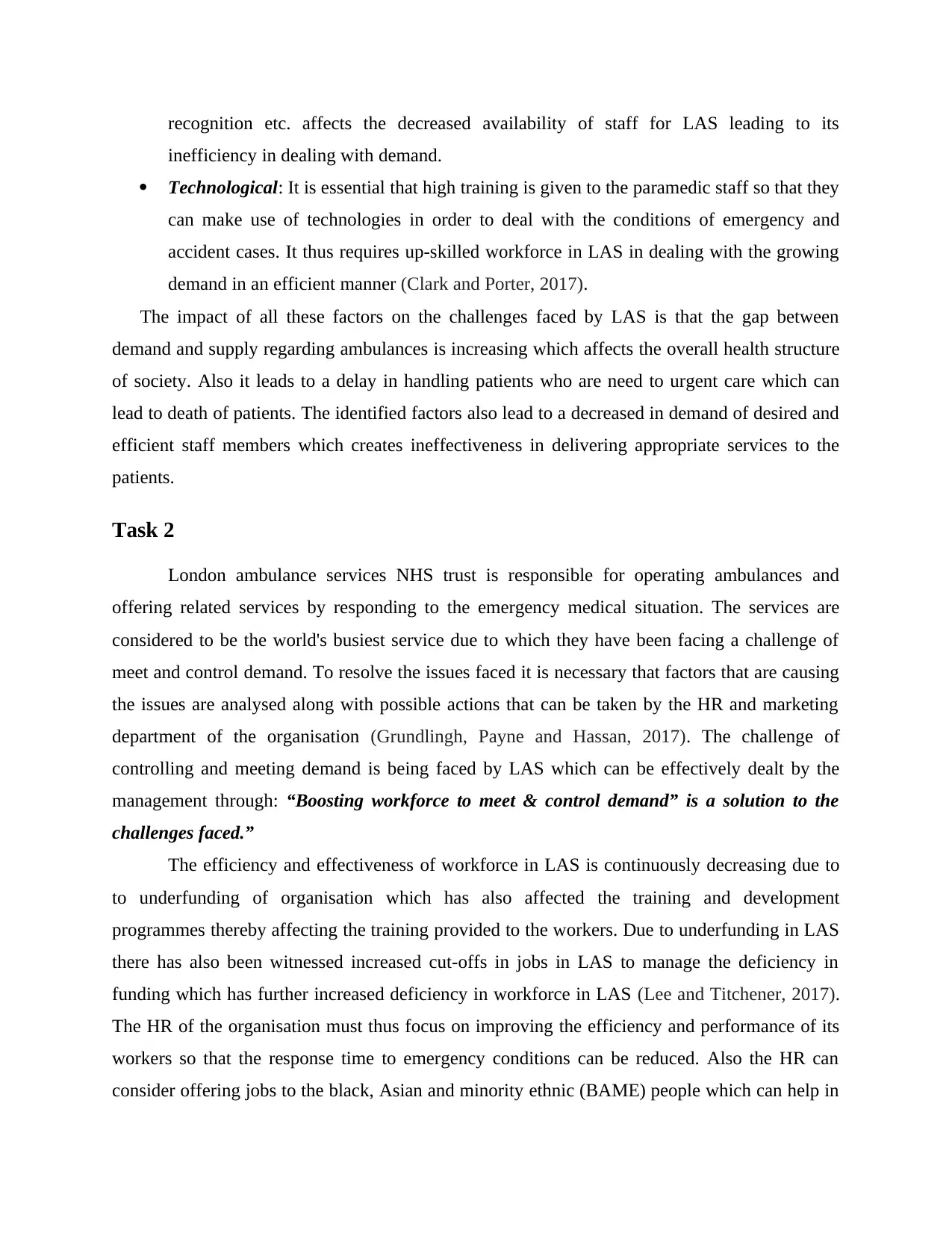
recognition etc. affects the decreased availability of staff for LAS leading to its
inefficiency in dealing with demand.
Technological: It is essential that high training is given to the paramedic staff so that they
can make use of technologies in order to deal with the conditions of emergency and
accident cases. It thus requires up-skilled workforce in LAS in dealing with the growing
demand in an efficient manner (Clark and Porter, 2017).
The impact of all these factors on the challenges faced by LAS is that the gap between
demand and supply regarding ambulances is increasing which affects the overall health structure
of society. Also it leads to a delay in handling patients who are need to urgent care which can
lead to death of patients. The identified factors also lead to a decreased in demand of desired and
efficient staff members which creates ineffectiveness in delivering appropriate services to the
patients.
Task 2
London ambulance services NHS trust is responsible for operating ambulances and
offering related services by responding to the emergency medical situation. The services are
considered to be the world's busiest service due to which they have been facing a challenge of
meet and control demand. To resolve the issues faced it is necessary that factors that are causing
the issues are analysed along with possible actions that can be taken by the HR and marketing
department of the organisation (Grundlingh, Payne and Hassan, 2017). The challenge of
controlling and meeting demand is being faced by LAS which can be effectively dealt by the
management through: “Boosting workforce to meet & control demand” is a solution to the
challenges faced.”
The efficiency and effectiveness of workforce in LAS is continuously decreasing due to
to underfunding of organisation which has also affected the training and development
programmes thereby affecting the training provided to the workers. Due to underfunding in LAS
there has also been witnessed increased cut-offs in jobs in LAS to manage the deficiency in
funding which has further increased deficiency in workforce in LAS (Lee and Titchener, 2017).
The HR of the organisation must thus focus on improving the efficiency and performance of its
workers so that the response time to emergency conditions can be reduced. Also the HR can
consider offering jobs to the black, Asian and minority ethnic (BAME) people which can help in
inefficiency in dealing with demand.
Technological: It is essential that high training is given to the paramedic staff so that they
can make use of technologies in order to deal with the conditions of emergency and
accident cases. It thus requires up-skilled workforce in LAS in dealing with the growing
demand in an efficient manner (Clark and Porter, 2017).
The impact of all these factors on the challenges faced by LAS is that the gap between
demand and supply regarding ambulances is increasing which affects the overall health structure
of society. Also it leads to a delay in handling patients who are need to urgent care which can
lead to death of patients. The identified factors also lead to a decreased in demand of desired and
efficient staff members which creates ineffectiveness in delivering appropriate services to the
patients.
Task 2
London ambulance services NHS trust is responsible for operating ambulances and
offering related services by responding to the emergency medical situation. The services are
considered to be the world's busiest service due to which they have been facing a challenge of
meet and control demand. To resolve the issues faced it is necessary that factors that are causing
the issues are analysed along with possible actions that can be taken by the HR and marketing
department of the organisation (Grundlingh, Payne and Hassan, 2017). The challenge of
controlling and meeting demand is being faced by LAS which can be effectively dealt by the
management through: “Boosting workforce to meet & control demand” is a solution to the
challenges faced.”
The efficiency and effectiveness of workforce in LAS is continuously decreasing due to
to underfunding of organisation which has also affected the training and development
programmes thereby affecting the training provided to the workers. Due to underfunding in LAS
there has also been witnessed increased cut-offs in jobs in LAS to manage the deficiency in
funding which has further increased deficiency in workforce in LAS (Lee and Titchener, 2017).
The HR of the organisation must thus focus on improving the efficiency and performance of its
workers so that the response time to emergency conditions can be reduced. Also the HR can
consider offering jobs to the black, Asian and minority ethnic (BAME) people which can help in
Paraphrase This Document
Need a fresh take? Get an instant paraphrase of this document with our AI Paraphraser
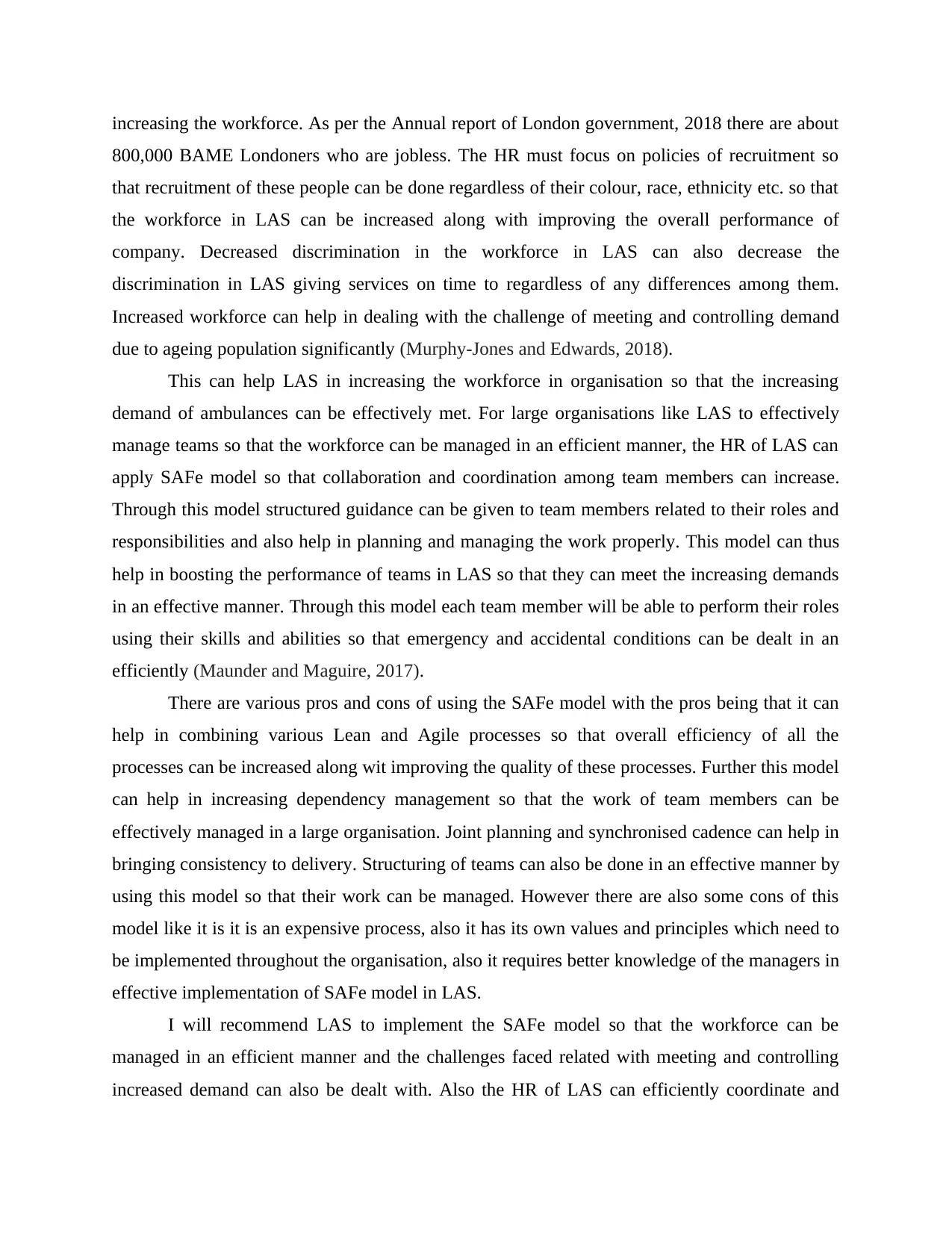
increasing the workforce. As per the Annual report of London government, 2018 there are about
800,000 BAME Londoners who are jobless. The HR must focus on policies of recruitment so
that recruitment of these people can be done regardless of their colour, race, ethnicity etc. so that
the workforce in LAS can be increased along with improving the overall performance of
company. Decreased discrimination in the workforce in LAS can also decrease the
discrimination in LAS giving services on time to regardless of any differences among them.
Increased workforce can help in dealing with the challenge of meeting and controlling demand
due to ageing population significantly (Murphy-Jones and Edwards, 2018).
This can help LAS in increasing the workforce in organisation so that the increasing
demand of ambulances can be effectively met. For large organisations like LAS to effectively
manage teams so that the workforce can be managed in an efficient manner, the HR of LAS can
apply SAFe model so that collaboration and coordination among team members can increase.
Through this model structured guidance can be given to team members related to their roles and
responsibilities and also help in planning and managing the work properly. This model can thus
help in boosting the performance of teams in LAS so that they can meet the increasing demands
in an effective manner. Through this model each team member will be able to perform their roles
using their skills and abilities so that emergency and accidental conditions can be dealt in an
efficiently (Maunder and Maguire, 2017).
There are various pros and cons of using the SAFe model with the pros being that it can
help in combining various Lean and Agile processes so that overall efficiency of all the
processes can be increased along wit improving the quality of these processes. Further this model
can help in increasing dependency management so that the work of team members can be
effectively managed in a large organisation. Joint planning and synchronised cadence can help in
bringing consistency to delivery. Structuring of teams can also be done in an effective manner by
using this model so that their work can be managed. However there are also some cons of this
model like it is it is an expensive process, also it has its own values and principles which need to
be implemented throughout the organisation, also it requires better knowledge of the managers in
effective implementation of SAFe model in LAS.
I will recommend LAS to implement the SAFe model so that the workforce can be
managed in an efficient manner and the challenges faced related with meeting and controlling
increased demand can also be dealt with. Also the HR of LAS can efficiently coordinate and
800,000 BAME Londoners who are jobless. The HR must focus on policies of recruitment so
that recruitment of these people can be done regardless of their colour, race, ethnicity etc. so that
the workforce in LAS can be increased along with improving the overall performance of
company. Decreased discrimination in the workforce in LAS can also decrease the
discrimination in LAS giving services on time to regardless of any differences among them.
Increased workforce can help in dealing with the challenge of meeting and controlling demand
due to ageing population significantly (Murphy-Jones and Edwards, 2018).
This can help LAS in increasing the workforce in organisation so that the increasing
demand of ambulances can be effectively met. For large organisations like LAS to effectively
manage teams so that the workforce can be managed in an efficient manner, the HR of LAS can
apply SAFe model so that collaboration and coordination among team members can increase.
Through this model structured guidance can be given to team members related to their roles and
responsibilities and also help in planning and managing the work properly. This model can thus
help in boosting the performance of teams in LAS so that they can meet the increasing demands
in an effective manner. Through this model each team member will be able to perform their roles
using their skills and abilities so that emergency and accidental conditions can be dealt in an
efficiently (Maunder and Maguire, 2017).
There are various pros and cons of using the SAFe model with the pros being that it can
help in combining various Lean and Agile processes so that overall efficiency of all the
processes can be increased along wit improving the quality of these processes. Further this model
can help in increasing dependency management so that the work of team members can be
effectively managed in a large organisation. Joint planning and synchronised cadence can help in
bringing consistency to delivery. Structuring of teams can also be done in an effective manner by
using this model so that their work can be managed. However there are also some cons of this
model like it is it is an expensive process, also it has its own values and principles which need to
be implemented throughout the organisation, also it requires better knowledge of the managers in
effective implementation of SAFe model in LAS.
I will recommend LAS to implement the SAFe model so that the workforce can be
managed in an efficient manner and the challenges faced related with meeting and controlling
increased demand can also be dealt with. Also the HR of LAS can efficiently coordinate and
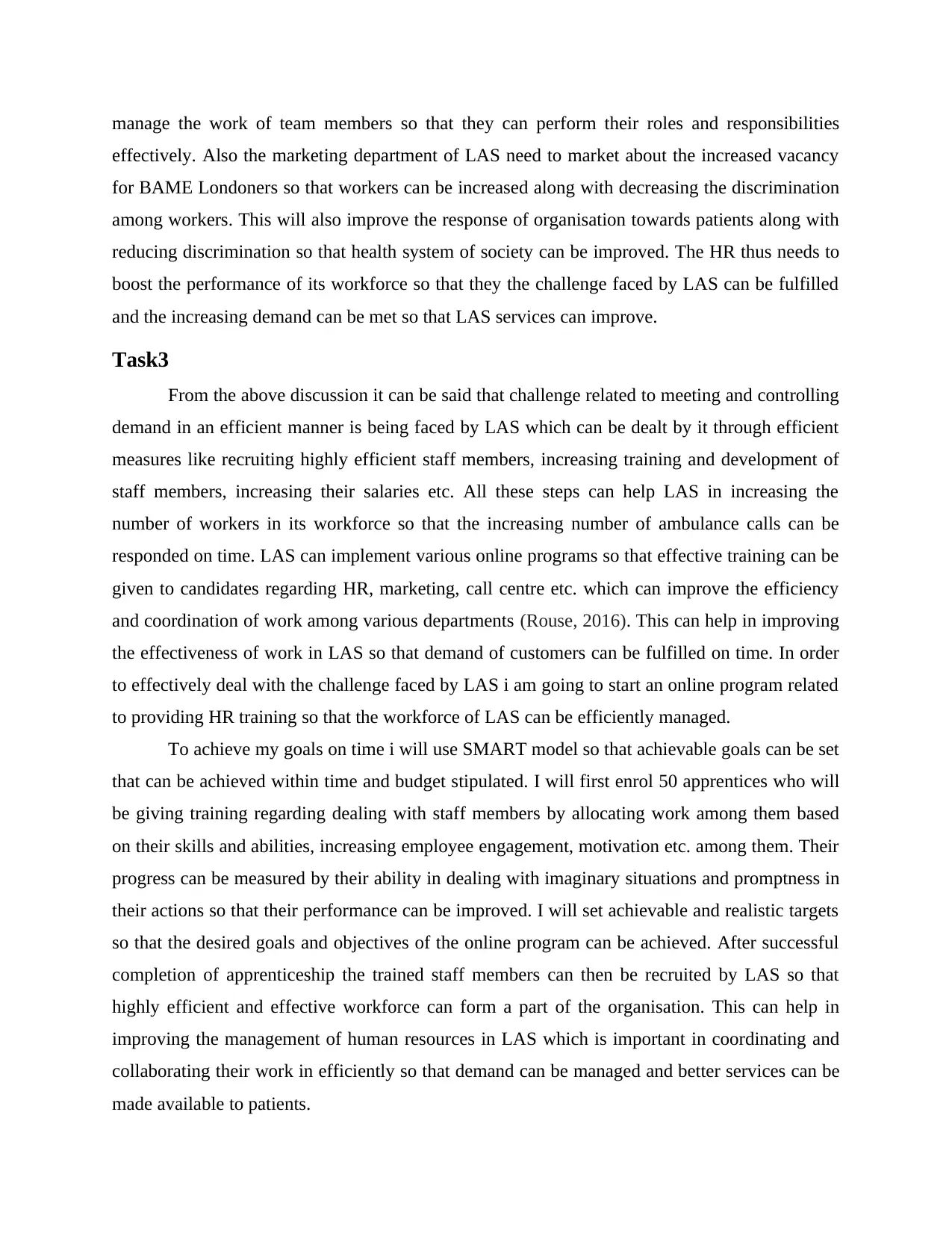
manage the work of team members so that they can perform their roles and responsibilities
effectively. Also the marketing department of LAS need to market about the increased vacancy
for BAME Londoners so that workers can be increased along with decreasing the discrimination
among workers. This will also improve the response of organisation towards patients along with
reducing discrimination so that health system of society can be improved. The HR thus needs to
boost the performance of its workforce so that they the challenge faced by LAS can be fulfilled
and the increasing demand can be met so that LAS services can improve.
Task3
From the above discussion it can be said that challenge related to meeting and controlling
demand in an efficient manner is being faced by LAS which can be dealt by it through efficient
measures like recruiting highly efficient staff members, increasing training and development of
staff members, increasing their salaries etc. All these steps can help LAS in increasing the
number of workers in its workforce so that the increasing number of ambulance calls can be
responded on time. LAS can implement various online programs so that effective training can be
given to candidates regarding HR, marketing, call centre etc. which can improve the efficiency
and coordination of work among various departments (Rouse, 2016). This can help in improving
the effectiveness of work in LAS so that demand of customers can be fulfilled on time. In order
to effectively deal with the challenge faced by LAS i am going to start an online program related
to providing HR training so that the workforce of LAS can be efficiently managed.
To achieve my goals on time i will use SMART model so that achievable goals can be set
that can be achieved within time and budget stipulated. I will first enrol 50 apprentices who will
be giving training regarding dealing with staff members by allocating work among them based
on their skills and abilities, increasing employee engagement, motivation etc. among them. Their
progress can be measured by their ability in dealing with imaginary situations and promptness in
their actions so that their performance can be improved. I will set achievable and realistic targets
so that the desired goals and objectives of the online program can be achieved. After successful
completion of apprenticeship the trained staff members can then be recruited by LAS so that
highly efficient and effective workforce can form a part of the organisation. This can help in
improving the management of human resources in LAS which is important in coordinating and
collaborating their work in efficiently so that demand can be managed and better services can be
made available to patients.
effectively. Also the marketing department of LAS need to market about the increased vacancy
for BAME Londoners so that workers can be increased along with decreasing the discrimination
among workers. This will also improve the response of organisation towards patients along with
reducing discrimination so that health system of society can be improved. The HR thus needs to
boost the performance of its workforce so that they the challenge faced by LAS can be fulfilled
and the increasing demand can be met so that LAS services can improve.
Task3
From the above discussion it can be said that challenge related to meeting and controlling
demand in an efficient manner is being faced by LAS which can be dealt by it through efficient
measures like recruiting highly efficient staff members, increasing training and development of
staff members, increasing their salaries etc. All these steps can help LAS in increasing the
number of workers in its workforce so that the increasing number of ambulance calls can be
responded on time. LAS can implement various online programs so that effective training can be
given to candidates regarding HR, marketing, call centre etc. which can improve the efficiency
and coordination of work among various departments (Rouse, 2016). This can help in improving
the effectiveness of work in LAS so that demand of customers can be fulfilled on time. In order
to effectively deal with the challenge faced by LAS i am going to start an online program related
to providing HR training so that the workforce of LAS can be efficiently managed.
To achieve my goals on time i will use SMART model so that achievable goals can be set
that can be achieved within time and budget stipulated. I will first enrol 50 apprentices who will
be giving training regarding dealing with staff members by allocating work among them based
on their skills and abilities, increasing employee engagement, motivation etc. among them. Their
progress can be measured by their ability in dealing with imaginary situations and promptness in
their actions so that their performance can be improved. I will set achievable and realistic targets
so that the desired goals and objectives of the online program can be achieved. After successful
completion of apprenticeship the trained staff members can then be recruited by LAS so that
highly efficient and effective workforce can form a part of the organisation. This can help in
improving the management of human resources in LAS which is important in coordinating and
collaborating their work in efficiently so that demand can be managed and better services can be
made available to patients.
⊘ This is a preview!⊘
Do you want full access?
Subscribe today to unlock all pages.

Trusted by 1+ million students worldwide
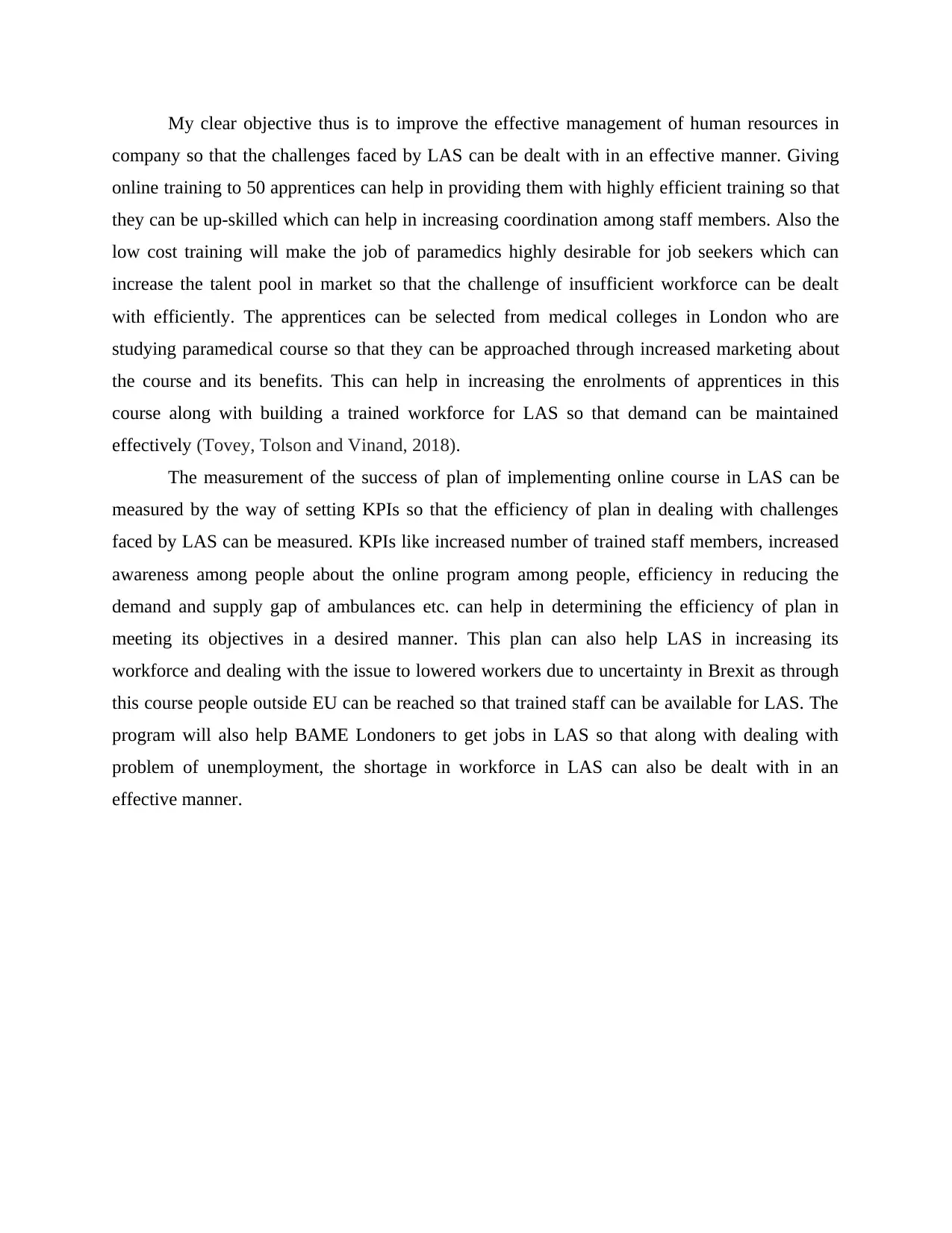
My clear objective thus is to improve the effective management of human resources in
company so that the challenges faced by LAS can be dealt with in an effective manner. Giving
online training to 50 apprentices can help in providing them with highly efficient training so that
they can be up-skilled which can help in increasing coordination among staff members. Also the
low cost training will make the job of paramedics highly desirable for job seekers which can
increase the talent pool in market so that the challenge of insufficient workforce can be dealt
with efficiently. The apprentices can be selected from medical colleges in London who are
studying paramedical course so that they can be approached through increased marketing about
the course and its benefits. This can help in increasing the enrolments of apprentices in this
course along with building a trained workforce for LAS so that demand can be maintained
effectively (Tovey, Tolson and Vinand, 2018).
The measurement of the success of plan of implementing online course in LAS can be
measured by the way of setting KPIs so that the efficiency of plan in dealing with challenges
faced by LAS can be measured. KPIs like increased number of trained staff members, increased
awareness among people about the online program among people, efficiency in reducing the
demand and supply gap of ambulances etc. can help in determining the efficiency of plan in
meeting its objectives in a desired manner. This plan can also help LAS in increasing its
workforce and dealing with the issue to lowered workers due to uncertainty in Brexit as through
this course people outside EU can be reached so that trained staff can be available for LAS. The
program will also help BAME Londoners to get jobs in LAS so that along with dealing with
problem of unemployment, the shortage in workforce in LAS can also be dealt with in an
effective manner.
company so that the challenges faced by LAS can be dealt with in an effective manner. Giving
online training to 50 apprentices can help in providing them with highly efficient training so that
they can be up-skilled which can help in increasing coordination among staff members. Also the
low cost training will make the job of paramedics highly desirable for job seekers which can
increase the talent pool in market so that the challenge of insufficient workforce can be dealt
with efficiently. The apprentices can be selected from medical colleges in London who are
studying paramedical course so that they can be approached through increased marketing about
the course and its benefits. This can help in increasing the enrolments of apprentices in this
course along with building a trained workforce for LAS so that demand can be maintained
effectively (Tovey, Tolson and Vinand, 2018).
The measurement of the success of plan of implementing online course in LAS can be
measured by the way of setting KPIs so that the efficiency of plan in dealing with challenges
faced by LAS can be measured. KPIs like increased number of trained staff members, increased
awareness among people about the online program among people, efficiency in reducing the
demand and supply gap of ambulances etc. can help in determining the efficiency of plan in
meeting its objectives in a desired manner. This plan can also help LAS in increasing its
workforce and dealing with the issue to lowered workers due to uncertainty in Brexit as through
this course people outside EU can be reached so that trained staff can be available for LAS. The
program will also help BAME Londoners to get jobs in LAS so that along with dealing with
problem of unemployment, the shortage in workforce in LAS can also be dealt with in an
effective manner.
Paraphrase This Document
Need a fresh take? Get an instant paraphrase of this document with our AI Paraphraser
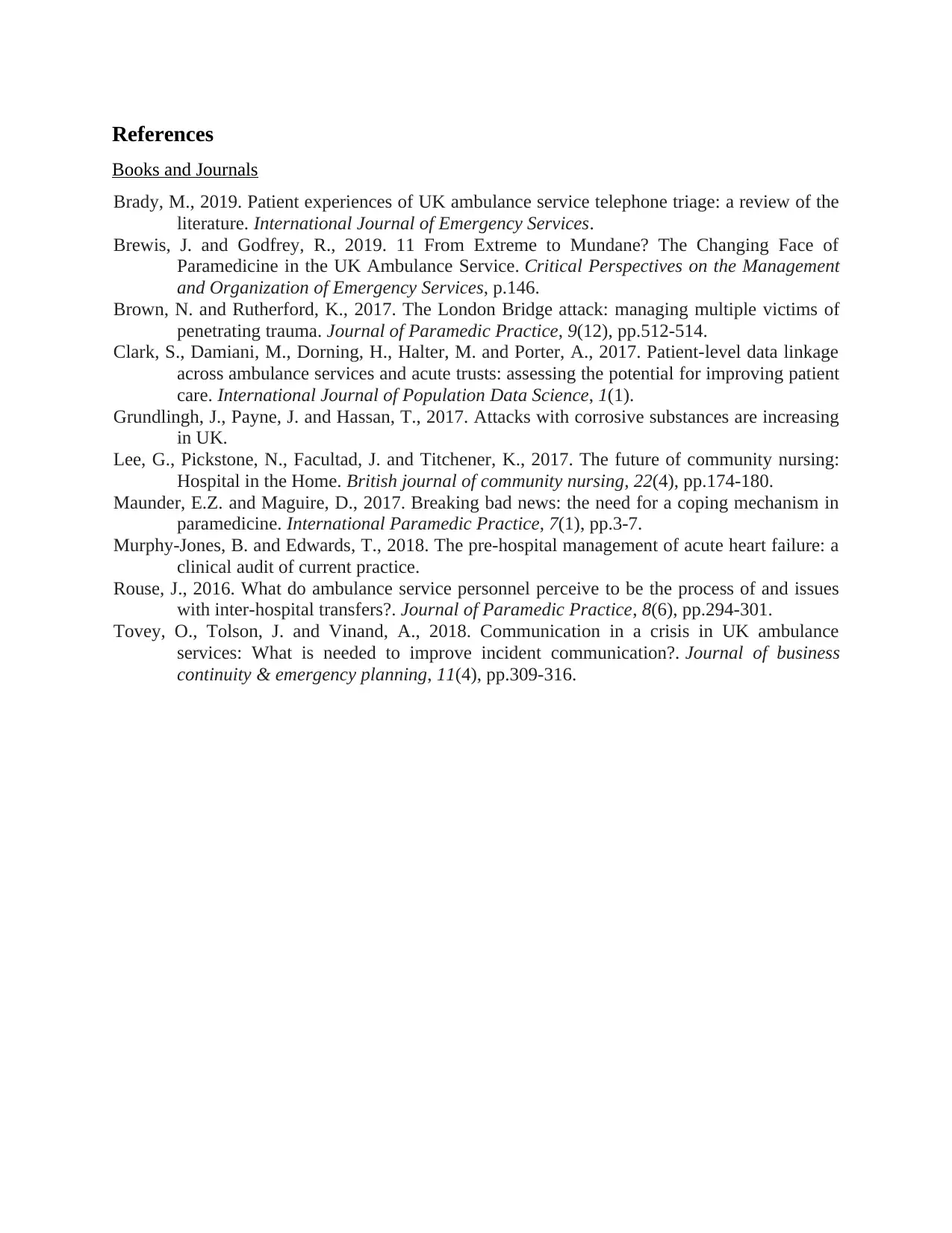
References
Books and Journals
Brady, M., 2019. Patient experiences of UK ambulance service telephone triage: a review of the
literature. International Journal of Emergency Services.
Brewis, J. and Godfrey, R., 2019. 11 From Extreme to Mundane? The Changing Face of
Paramedicine in the UK Ambulance Service. Critical Perspectives on the Management
and Organization of Emergency Services, p.146.
Brown, N. and Rutherford, K., 2017. The London Bridge attack: managing multiple victims of
penetrating trauma. Journal of Paramedic Practice, 9(12), pp.512-514.
Clark, S., Damiani, M., Dorning, H., Halter, M. and Porter, A., 2017. Patient-level data linkage
across ambulance services and acute trusts: assessing the potential for improving patient
care. International Journal of Population Data Science, 1(1).
Grundlingh, J., Payne, J. and Hassan, T., 2017. Attacks with corrosive substances are increasing
in UK.
Lee, G., Pickstone, N., Facultad, J. and Titchener, K., 2017. The future of community nursing:
Hospital in the Home. British journal of community nursing, 22(4), pp.174-180.
Maunder, E.Z. and Maguire, D., 2017. Breaking bad news: the need for a coping mechanism in
paramedicine. International Paramedic Practice, 7(1), pp.3-7.
Murphy-Jones, B. and Edwards, T., 2018. The pre-hospital management of acute heart failure: a
clinical audit of current practice.
Rouse, J., 2016. What do ambulance service personnel perceive to be the process of and issues
with inter-hospital transfers?. Journal of Paramedic Practice, 8(6), pp.294-301.
Tovey, O., Tolson, J. and Vinand, A., 2018. Communication in a crisis in UK ambulance
services: What is needed to improve incident communication?. Journal of business
continuity & emergency planning, 11(4), pp.309-316.
Books and Journals
Brady, M., 2019. Patient experiences of UK ambulance service telephone triage: a review of the
literature. International Journal of Emergency Services.
Brewis, J. and Godfrey, R., 2019. 11 From Extreme to Mundane? The Changing Face of
Paramedicine in the UK Ambulance Service. Critical Perspectives on the Management
and Organization of Emergency Services, p.146.
Brown, N. and Rutherford, K., 2017. The London Bridge attack: managing multiple victims of
penetrating trauma. Journal of Paramedic Practice, 9(12), pp.512-514.
Clark, S., Damiani, M., Dorning, H., Halter, M. and Porter, A., 2017. Patient-level data linkage
across ambulance services and acute trusts: assessing the potential for improving patient
care. International Journal of Population Data Science, 1(1).
Grundlingh, J., Payne, J. and Hassan, T., 2017. Attacks with corrosive substances are increasing
in UK.
Lee, G., Pickstone, N., Facultad, J. and Titchener, K., 2017. The future of community nursing:
Hospital in the Home. British journal of community nursing, 22(4), pp.174-180.
Maunder, E.Z. and Maguire, D., 2017. Breaking bad news: the need for a coping mechanism in
paramedicine. International Paramedic Practice, 7(1), pp.3-7.
Murphy-Jones, B. and Edwards, T., 2018. The pre-hospital management of acute heart failure: a
clinical audit of current practice.
Rouse, J., 2016. What do ambulance service personnel perceive to be the process of and issues
with inter-hospital transfers?. Journal of Paramedic Practice, 8(6), pp.294-301.
Tovey, O., Tolson, J. and Vinand, A., 2018. Communication in a crisis in UK ambulance
services: What is needed to improve incident communication?. Journal of business
continuity & emergency planning, 11(4), pp.309-316.
1 out of 8
Related Documents
Your All-in-One AI-Powered Toolkit for Academic Success.
+13062052269
info@desklib.com
Available 24*7 on WhatsApp / Email
![[object Object]](/_next/static/media/star-bottom.7253800d.svg)
Unlock your academic potential
Copyright © 2020–2025 A2Z Services. All Rights Reserved. Developed and managed by ZUCOL.



